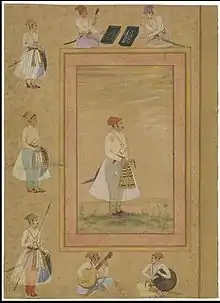Ram Singh I
Ram Singh I was the Raja of the Kingdom of Amber and head of the Kachwaha Rajput clan, succeeding his father Jai Singh I. He was also a general of the Mughal Empire and Subahdar of Kashmir.
| Ram Singh I | |||||
|---|---|---|---|---|---|
| Raja of Amber | |||||
 | |||||
| Reign | 1667–1688 | ||||
| Coronation | 10 September 1667 | ||||
| Predecessor | Jai Singh I | ||||
| Successor | Bishan Singh | ||||
| Born | 1640 Amber, Rajputana | ||||
| Died | 30 April 1688 (aged 47–48) Kohat, Pakhtunkhwa, Mughal Empire | ||||
| Issue |
| ||||
| |||||
| Dynasty | Kacchwaha | ||||
| Father | Jai Singh I | ||||
| Mother | Anand Kunwar Chauhan [1] | ||||
| Religion | Hinduism | ||||
He was commissioned by the Mughal Emperor Aurangzeb as a commander of 4000 in 1667[2] to invade the Ahom kingdom of present-day Assam,[3] but the loss at the Battle of Saraighat (1671) and the subsequent retreat[4] led to his recall and disgrace.[5]
Escape of Shivaji
After the incomplete Mughal invasion of Bijapur in 1665, Maratha king Shivaji was sent to the Mughal court in Agra on 12 May 1666. Shivaji was offended by being made to stand alongside relatively low-ranking nobles,[6] stormed out of the court, and was promptly placed under house arrest. Ram Singh was granted custody of Shivaji and his son Sambhaji.[7]
Shivaji's situation under house arrest was precarious. Aurangzeb's court deliberated whether to execute him or keep him as a servant. Jai Singh, having assured Shivaji of his personal safety, tried to influence Aurangzeb's decision.[8] However, Aurangzeb intended to kill Shivaji and ordered Faulad Khan to transfer Shivaji from Ram Singh's custody to the house of Radanaza Khan. Ram Singh refused to deliver over Shivaji because of his father's promise of safety to Shivaji and said he should be slain first to kill Shivaji. Aurangzeb made him to sign security bond for Shivaji.[9]
Shivaji devised a strategy to secure his freedom. He ordered the majority of his troops home and urged Ram Singh to withdraw his pledges to the emperor for the safe custody of himself and his son.[10] Shivaji escaped and left Agra on August 17, 1666, by putting himself in one of the enormous baskets and his son Sambhaji in another.
After Shivaji's escape, Ram Singh was accused of assisting Shivaji's escape and was punished, first by being barred from entering court and subsequently by being demoted.[11]
Ahom campaign
Ram Singh was forced to fight Ahom kingdom with 21 Rajput chiefs, his own 4,000 soldiers, 1,500 ahadis (Mughal emperor's own household troops), 500 artillerymen, and with the reinforcements from Bengal, numbers totalled up to 30,000 infantry, 18,000 Turkish cavalry, and 15,000 Koch archers.[12]
The weaker Ahom army wore down the massive Mughal army through guerrilla tactics and clever diplomatic negotiations to buy time before decisively winning the naval Battle of Saraighat against the weak Mughal navy. This defeat and the subsequent retreat to Bengal ended the Mughal expansion into Assam.
Death
Ram Singh grew sick of war and finally, in 1676 he was allowed to leave and return to his province. He was later posted in Kohat where he died in 1688.[13] He was succeeded by his grandson Bishan Singh as the Raja of Amber.
Notes
- Jaipur that was: Royal Court and the Seraglio. p. 56.
- "Learning of the loss of Kamrup on 19th December 1667, Aurangzeb decided to at once retrieve imperial prestige and regain lost dominion" (Sarkar 1992:211)
- "(Aurangzeb) commissioned Ram Singh of Amber, son of the distinguished general Mirza Rajah Jai Singh, and a commander of 4000, to lead an invasion of Assam." (Sarkar 1992:211)
- "Weakened by repeated defeats and consequent losses and losing all hopes of recovering imperial grace by defeating the Ahom monarch, Ram Singh left Kamrup in early April 1671 and returned to Rangamati." (Sarkar 1992:227)
- "Aurangzeb at once demoted the Rajput general by 2000 and ordered his recall. Accordingly, he made over charge to Abu Nisar Khan and had audience with the Emperor on 25 June 1676." (Sarkar 1992:228)
- Gordon, Stewart (1994). Marathas, Marauders, and State Formation in Eighteenth-century India. Oxford University Press. p. 206. ISBN 978-0-19-563386-3.
- Jain, Meenakshi (1 January 2011). THE INDIA THEY SAW (VOL-3). Prabhat Prakashan. pp. 299, 300. ISBN 978-81-8430-108-3.
- Gordon, Stewart (1 February 2007). The Marathas 1600–1818. Cambridge University Press. p. 76. ISBN 978-0-521-03316-9.
- Shivaji and his times : Sarker, Jadunath : Free Download, Borrow, and Streaming : Internet Archive. 14 January 2022. Retrieved 30 April 2022 – via Internet Archive.
- Sarkar, Jadunath (1994). A History of Jaipur: C. 1503–1938. Orient Blackswan. ISBN 978-81-250-0333-5.
- Shivaji and his times : Sarker, Jadunath : Free Download, Borrow, and Streaming : Internet Archive. 14 January 2022. Retrieved 30 April 2022 – via Internet Archive.
- S.K. Bhuyan (1957). Lachit Borphukan and his times. Government of Assam in the Department of Historical and Antiquarian Studies. p. 34.
- Sarkar, Jadunath (1994). A History of Jaipur:1503-1938. Orient Longman. pp. 146–147. ISBN 9788125003335.
Ram Singh was sent to Assam as a punishment for secretly helping Shivaji....He (Ram Singh) had only 8,000 troopers under his standard....The Ahoms, being a nation in arms, mustered 100,000
References
- Sarkar Jadunath (1984, reprint 1994). A History of Jaipur, New Delhi: Orient Longman, ISBN 81-250-0333-9.
- Sarkar, J. N. (1992), "Chapter VIII Assam-Mughal Relations", in Barpujari, H. K. (ed.), The Comprehensive History of Assam, vol. 2, Guwahati: Assam Publication Board, pp. 148–256